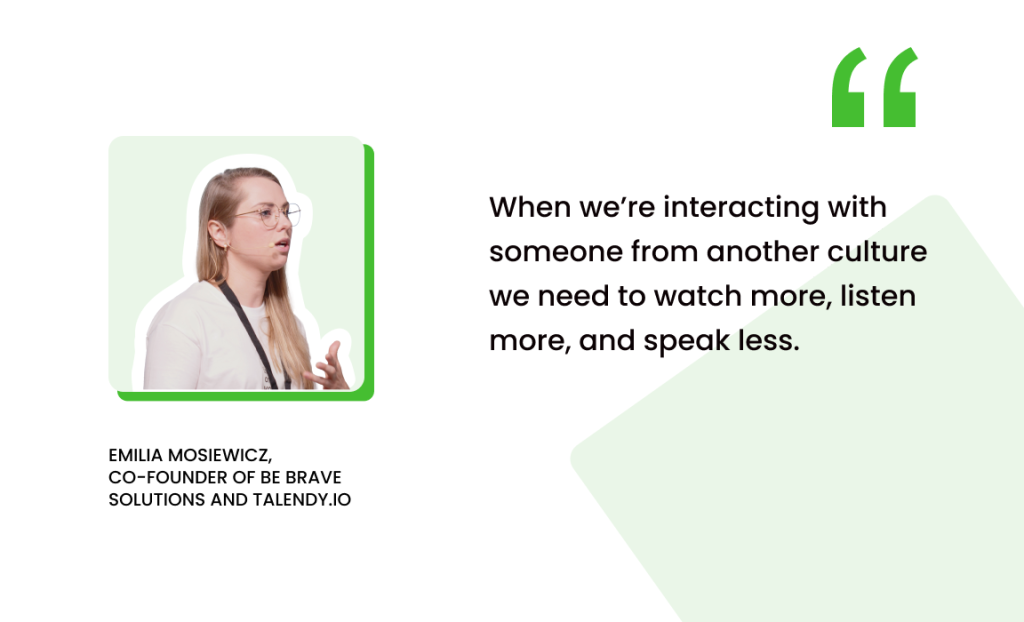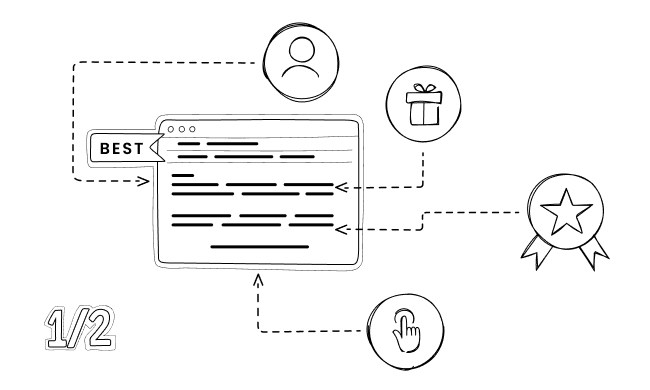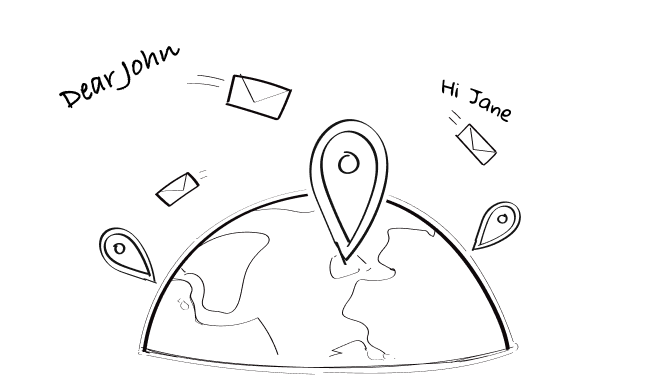An American tourist goes into a travel agency in Japan and says “Hi, I need to buy a plane ticket from City A to City B.”
The Japanese travel agent hesitates for a moment and says “Perhaps you would prefer to fly from City A to City C?”
“No,” says the American. “City A to City B, please”.
After more hesitation and staring at her computer screen, the travel agent says “Maybe instead you would like to fly from City A to City D?”, causing the tourist to get irritated.
“What’s wrong with her?” the tourist asks himself. “I’ve said twice that I want to fly from City A to City B and both times she suggests that I fly somewhere else. Her English seems fine so what’s going on?”
Culture clashes happen
What’s going on here is a collision on a culture map. In Japanese culture, it’s not polite to directly tell someone they can’t do something. There is no flight from City A to City B. That’s what the travel agent was telling the tourist by repeatedly recommending that he fly somewhere else.
In American culture, it’s normal to expect direct answers. Even if it’s not what you wanted to hear. If there is no flight from City A to City B, then just tell me.
Both people involved here are reacting in the way that’s normal for them but, at the same time, their “normal” is far from the expectations of the other person.
Now take this situation and multiply it by the scale of international commerce and the email communication that goes with it. You’ll start to see just how helpful a culture map can be.
What a culture map does
When your emails cross borders, they do more than enter a new country. They enter a new set of expectations, standards, norms, customs and ways of communicating. Even when you’re speaking the same language. It’s easy to step outside the accepted boundaries of the unspoken rules of what’s ok and normal and what isn’t.
Last year, we organized a number of presentations to help a range of people from different backgrounds who use cold email to get their message out, one conversation at a time.
Among them was a presentation by Emilia Mosiewicz. She is a corporate trainer who helps businesses deal with international barriers, who spoke on the topic of adjusting your communication to fit the norms and expectations of your target audience. Many of the concepts she discussed were borrowed from the book by Erin Meyer that put the subject in the spotlight for people around the world with a sales and marketing background, The Culture Map.
The main takeaway can be summarized like this:
- There are differences in cultural norms of communication from one culture to another
- These differences have an impact on how people in those cultures respond to communication. Especially to messaging that goes outside of expected parameters
- We should make some kind of effort to tailor our communications sent to different cultures to avoid misunderstandings and create a comfort level that allows us to get our message across
- Failure to do this can mean you might be stuck asking about the plane from City A to City B all day while remaining clueless about why you’re getting nowhere

It’s important to stress that we’re talking about using an actual map here. Well, it’s more like a chart than a map but, still, it’s a visual representation of where a particular culture sits in relation to others based on two measures of their communication style.
Let’s turn to what a culture map typically looks like.
Making your map
The main function of a culture map is to satisfy the need to put some thought into how your target audience compares to others based on a four-quadrant area that charts the position of different countries and cultures according to whatever metrics you want to use.
In the case of cold emailing and the relevant factors, we’ll choose two measures — how emotionally expressive a culture is, charted above and below the horizontal axis and how confrontational a culture is, charted to the left and right of a vertical axis.
So, for example, the lower-right quadrant would be populated with countries or cultures with subtle, nuanced communication and a lot of reading between the lines. “Maybe you would prefer to fly to City C?”
In the upper left, for example, you might have an American tourist and his frustrating attempts to get a reply to a simple request. You get the idea.
Yes, the placement of these countries is somewhat subjective but we can agree that there are some characteristics that define certain peoples and cultures when it comes to the way we communicate.
Using your map
When your map is fully populated with different people and cultures, the differences between them will become more clear. So will the distances between them. The challenges of speaking clearly from one quadrant to another suddenly come into focus.
Are you speaking to someone who is probably in the same quadrant as you are? Only minimal changes might be necessary, or maybe none at all. One quadrant up, down, left or right? More substantial changes in your approach are probably needed. Moving diagonally up or down? Be careful because you’re talking to people who approach conversations very differently than you do.
Even what look like small steps require careful consideration. You might think the content of your cold emails, for example, would be virtually identical when writing to an American or British audience. Just a few small spelling changes here and there, right? Not so — the differences are bigger than you think.
So if you have to be careful there, imagine what you might need to consider when your email outreach has to cross even greater distances on your culture map.
Bridging gaps with “How”
Depending on whom you’re writing to, you could be faced with a challenging task. Finding the right tone, approach and choice of words might not be easy.
Still, there are some universal tips that work no matter what language barriers might be in the way. One of them is the use of calibrated questions.
In your cold email outreach, it’s a good idea to stay away from closed questions with a simple yes-or-no answer. “Do you have time to discuss this?”, “Are you using this approach in your sales now?”, “Does your team use this tool?” etc. all give the prospect the chance to answer with a simple yes or no and end the conversation. Then where do you go?
Avoiding the yes-or-no trap is always a good idea but it’s especially true when writing across cultures. Getting a conversation started is already hard enough without giving your email recipients the opportunity to slam the virtual door in your face with a one-word answer.
That’s where calibrated questions come in. Calibrated questions keep the conversation going, asking for information and inviting the other side to talk, not just answer a question. They usually begin with “How “ or “What” and set up the other side of the conversation to take over.
“How are you dealing with rising prices in your supply chain?”, “How do you plan to reach your sales goals?”, “What are the signs that your campaign will be successful?”, “How are you going to increase production next year” etc. These are examples of calibrated questions.
“How” can you make it easier to start conversations?
In your cold email outreach to other cultures, making it easier to engage using calibrated questions can help to overcome any problems you might have with cross-cultural language mistakes. Even though the delivery might not be perfect, you can still make it clear that you’re interested in dealing with the issues that your prospect is facing.
Asking “How are you attracting users for your app?” or “How are you recruiting participants for your partner program?” are not only clear about what you want to talk about, they invite the prospect to go well beyond what a yes-or-no question would require.
That’s how you get conversations started no matter how far apart you are on a culture map.
Want to see the full presentation with more examples? You can view the entire video here.
READ ALSO

Best Cold Email I Ever Got: Analyzing 4 Real-life Examples (Part 1)
This is the blog post you’ve been waiting for… trust me. I asked four people from the Woodpecker team about the best cold email they ever got, and ran an in-depth analysis of their subject lines, email body and CTA.

Cold Email Outreach in the US & the UK: What Works?
To get the best advice on reaching prospects in markets where everyone *ekhm* wants a slice of the cold email pie, I talked to a few Woodpecker Experts who consistently generate leads in those markets: Veth Group, Nerdwise, We Are Team Rocket, and LevelUp Leads.

10 Factors that Make Our Cold Emails Work (or Not)
If you're sending cold emails, you know that sometimes your messages work amazingly well, sometimes they work OK, and sometimes they don't work at all. And whether your outreach works great, or it hardly works at all, there's always a reason for that. Actually, in most cases, there's a whole collection of reasons for that. Here's a list of 10 factors that you may want to check to discover the cause of your campaign's success or failure, and to improve the effectiveness of your emails in general.
